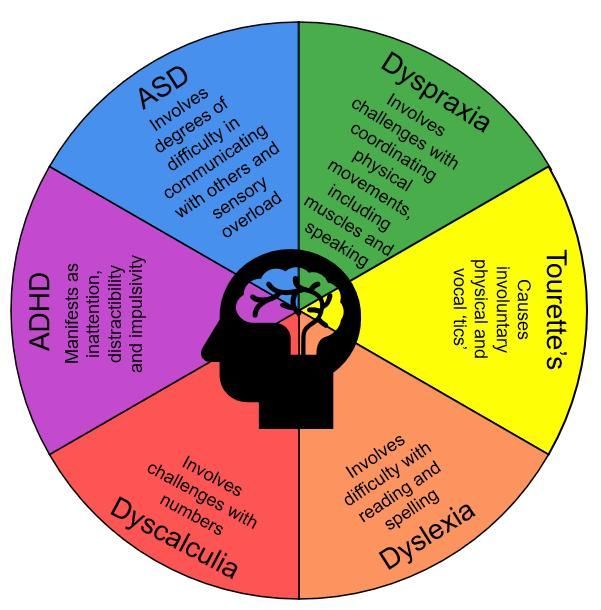NEURO-DEVELOPMENTAL (Neuro-divergent) CONDITIONS


Neurodiversity is a termed used to describe the range of differences in human brain functions and their associated behavioural traits.
- It describes the variation in how people experience the world.
- It's influenced by genetics and environmental factors
While a large proportion of people's brain's functions (information processing and communication) and behavioural traits tend to fall within certain close range of the percentile, a smaller percentage fall outside of the range. People in the first group are referred to as Neuro-typical while the people in the second group are referred to as Neuro-divergent.
The following are grouped within the umbrella of Neuro-Divergent Conditions:
- Autism,
- ADHD (attention deficit hyperactivity disorder),
- Dyscalculia,
- Dyslexia,
- Dyspraxia
- Tourette's syndrome.
All these conditions have a spectrum with some individuals experiencing only limited challenges relating to their conditions while others experience more extreme challenges. While neuro-divergent conditions can often occur alongside mental health challenges (e.g. anxiety, depression, addiction), mental health issues are distinct from neuro-divergent conditions.
Prevalence of Neuro-divergent conditions:
It is estimated that:
- Around 15% (or 1 in 7) of people in the UK are neuro-divergent.
- Between 10% and 20% of the world's population is neuro-divergent.
This means that this group of people's brains function, learn, and process information differently
ATTENTION DEFICIT, HYPERACTIVITY DISORDERS (ADHD)
Description of condition
- Affects how people communicate and interact with the world.
Prevalence (UK)
- Estimated at 3 to 4 per 100 adults.
Examples of attributes
- Creativity
- Ability to cope well in a crisis
- Ability to ‘hyper-focus’ on a specific task
- Intuitive and detailed-oriented
- Empathetic and intuitive
- Ability to be flexible and spontaneous.
- Often bring optimism to the workplace.
Examples of challenges
- Concentration
- Causes restlessness and impulsivity (in some cases)
- Focus
- Pay attention at meetings
- Manage/organise their time
- Stay on top of their workload
- Follow instructions
- Meet deadlines
- Communicate with their co-workers
- Follow through with what they’re supposed to do
Autistic Spectrum Disorders (ASD)
Description of condition
- A lifelong developmental condition which affects how people communicate and interact with the world the effects of which can differ from person to person.
Prevalence (UK)
- Around 1 in 100 people
Examples of attributes
- Memorising and learning information quickly
- Logical thinking ability
- Extraordinarily good memory
- Being precise and detail orientated
- Honesty and reliability Punctual
- Strong adherence to rules
- Able to concentrate for long periods of time (when motivated)
- Capability for alternate problem solving
- Punctual
Examples of challenges
- Social interaction
- Making eye contact
- Reacting to body language, such as smiling
- Uncomfortable experiencing certain tastes, smells or sounds
Dyscalculia
Description of condition
- Makes it difficult to understand and work with numbers, perform calculations, and remember mathematical facts.
Prevalence (UK)
- About 1 in 20 people
Examples of attributes
- Creativity
- Strategic thinking
- Practical ability
- Problem solving
- Often exceptional reading
- Writing and spelling
- Intuitive thinking
Examples of challenges
- Counting backwards
- Weak mental arithmetic
- Skills difficulty
- Difficulty understanding graphs or charts
- Poor time management
- Difficulty using applications such as Excel
Dyspraxia
Description of condition
Affects physical coordination and balance. it is also known as developmental coordination disorder (DCD)
Prevalence (UK)
- 1 in 10 people
Examples of attributes
- Hardworking and usually highly motivated
- Highly determined individuals with great potential in the workplace
- Creative original thinkers
- Good strategic problem-solvers
Examples of challenges
- Ability to develop their own strategies to overcome difficulties
- Ability to plan sequences of movement
- Perceived clumsy movement
Dyslexia
Description of condition
- Impacts literacy and certain abilities used for learning, including reading and writing, remembering and processing information.
Prevalence (UK)
- 1 in 10 people
Examples of attributes
- Good problem-solving ability
- Creativity
- Very observant
- High levels of empathy
- Good at making connections
- Strong narrative reasoning
- Three-dimensional thinking
Examples of challenges
- Read and write slowly
- Confuse the order of letters in words
- Confused by letters that look similar and write letters the wrong way round (such as "b" and "d")
- Have poor or inconsistent spelling
- Understand information when told verbally, but have difficulty with information that's written down
- Find it hard to carry out a sequence of directions
- Struggle with planning and organisation




